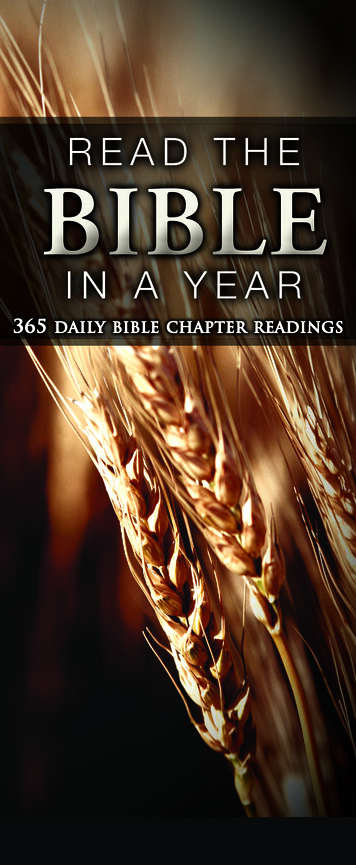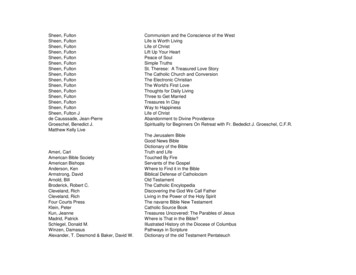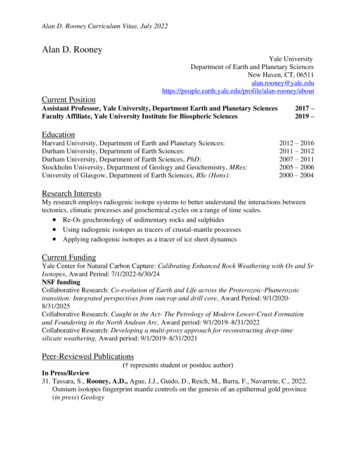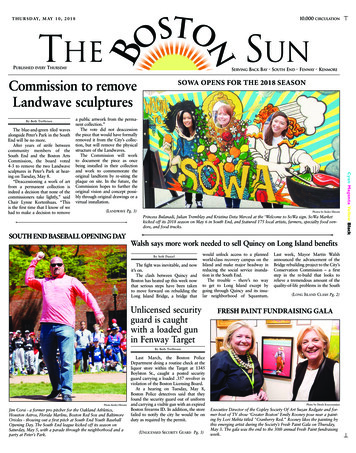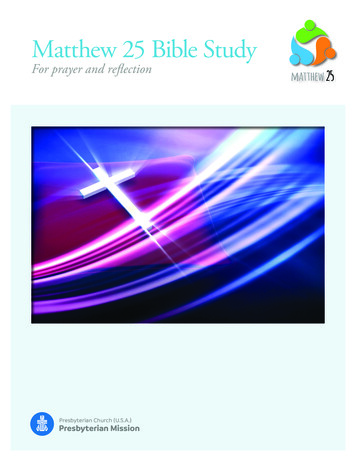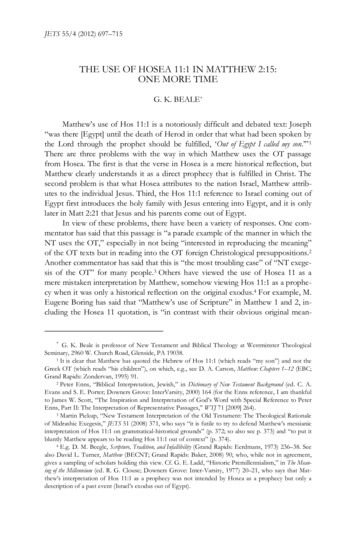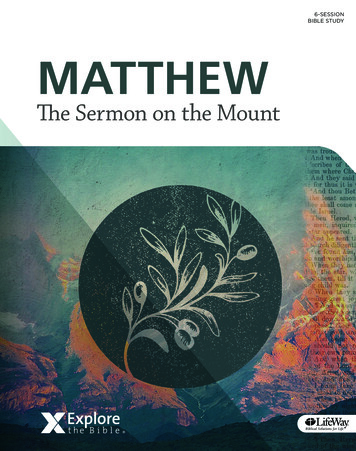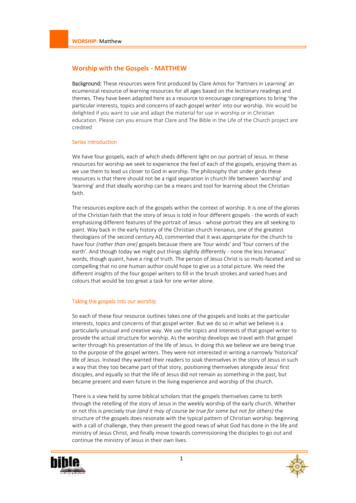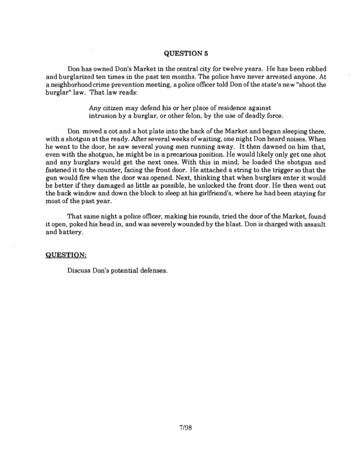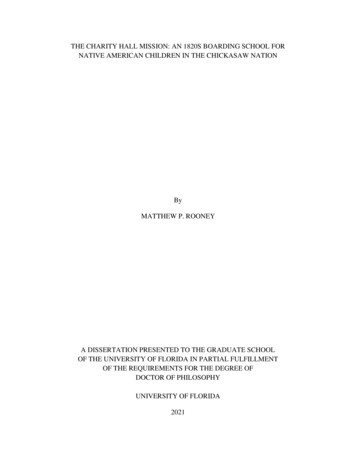
Transcription
THE CHARITY HALL MISSION: AN 1820S BOARDING SCHOOL FORNATIVE AMERICAN CHILDREN IN THE CHICKASAW NATIONByMATTHEW P. ROONEYA DISSERTATION PRESENTED TO THE GRADUATE SCHOOLOF THE UNIVERSITY OF FLORIDA IN PARTIAL FULFILLMENTOF THE REQUIREMENTS FOR THE DEGREE OFDOCTOR OF PHILOSOPHYUNIVERSITY OF FLORIDA2021
2021 Matthew P. Rooney
ACKNOWLEDGEMENTSI thank first of all The Chickasaw Nation for supporting my research project bothfinancially and spiritually. Having the Chickasaw Explorers participate in the archaeologicalfield excavations was an experience that I hope will become more common in research projectswhere the ancestors of living peoples are involved. In particular, I thank Dr. Brad R. Lieb,Director of Chickasaw Nation Archaeology and Field Studies, who introduced me to the site ofCharity Hall, worked as a liaison with the landowner, and facilitated the project with tools andlabor. I thank the landowner, A.G. Doss, who graciously allowed us to return year after year tohis property and gave us open access to perform the fieldwork we deemed necessary to delineateand understand the site. Mr. Doss was very accommodating, always agreeing to sit with us totalk about the modern history of the site as well as to identify objects that were foreign to us butfamiliar to him. I also thank the Wenner Gren Foundation for funding one of the three fieldseasons, and crew members Tara Skipton, Domenique Sorresso, Dr. Mark Donop, Caleb Hutson,Gabe Griffin, and Bryce Krumcke for their excellent work. I thank Sorresso additionally forassisting in the initial laboratory cleaning and sorting of artifacts, and Skipton for alsoparticipating in laboratory cleaning, sorting, and analysis, as well as her work transcribing aselection of the Reverend Bell’s letters. I also thank Nicolas Delsol for analyzing and quantifyingthe faunal assemblage recovered from Charity Hall.I thank Dr. Lindsay Bloch, collections manager for the Ceramic Technology Laboratoryand Florida Archaeology at the Florida Museum of Natural History, for helping me identifyspecific historical artifact types, especially ceramics and buttons. I also thank Ann S. Cordell,former manager of the Ceramic Technology Laboratory, for helping me identify various clay andstone artifacts. I thank Mitch Caver and Rufus Ward, local historians who provided invaluable3
assistance with retrieving primary-source documents related to Charity Hall. Caver, for instance,tracked down the field notes from the 1834 land survey, and Ward furnished copies ofmissionary journals as well as made his personal collection and expertise of tableware availablefor comparison to objects I recovered from Charity Hall. I here also thank Susan Knight Gore,Archivist of the Historical Foundation of the Cumberland Presbyterian Church, who welcomedme to her archive and furnished me with every primary-source document she could find that hadsome relation to the Chickasaws or Choctaws. I also thank Wayne Knox, Director of the AmoryRegional Museum in Monroe County, Mississippi, who provided me with important secondarysources penned by local authors and had discussions with me about the history of Cotton GinPort. I also thank the Department of Anthropology at the University of Florida for awarding me afour-year graduate fellowship as well as an additional year of funding through research andteaching assistantships. I could not have performed any of this work without their financialsupport.Next I thank my dissertation committee. Dr. James M. Davidson gave me a primer onnineteenth-century artifacts and had discussions with me about how to interpret what I found atCharity Hall. Dr. Jon F. Sensbach sat with me early on to review the historical mission literatureand provided me with recommendations on research directions regarding my historical research.Dr. Kenneth E. Sassaman served as a great champion of my initial acceptance into the graduateprogram at the University of Florida and asked insightful questions about my research thatencouraged me to dig deeper and more thoroughly into my sources. Finally, I thank mycommittee chair, Dr. Charles R. Cobb, about whom I cannot write enough glowing words toencapsulate what his patience and guidance have done for my development as a scholar. Charlieprovided me with this research project, various avenues of funding, and many critical but4
generous words to push me to make this dissertation the strongest and most meaningful work Ihave ever produced. He is a fountain of knowledge and inspiration that took me in manytheoretical directions I did not expect and to literature and ideas that I probably never would havecombined on my own.On the personal side, I thank the host of new friends I made while living in the City ofHigh Springs throughout the duration of this research project. I also thank the many virtualfriends that I have made over these years, who together with those I made locally helped keep mesane and focused on my goals. I thank my former wife Crystal Wheeler and her husband TroyWheeler for facilitating my journey through graduate school and ensuring that my children weresafe and cared for during the times when they were not with me. I thank my children, ErinRooney and Quinlan Rooney, for giving me the love and impetus and drive to be the best personI can be. Finally, I thank my late father Peter Rooney and my mother Dr. Dana R. Hicks forproviding me with early guidance and inspiration and encouragement to contribute somethingmeaningful to this world. My mother in particular has served as a great inspiration to me andprovided me with both the emotional and financial support I needed to survive during mydevelopment as a scholar.5
TABLE OF CONTENTSACKNOWLEDGEMENTS .3LIST OF TABLES .8LIST OF FIGURES .10ABSTRACT.12CHAPTER1AMONG THE “TAWNY SONS OF THE WOODS” .14Colonial Missionscapes .18Materiality of Civilization .23Dissertation Organization .252COLONIALISM, MATERIALITY, AND NETWORKS.27Materiality as a Theory of Material Culture .31Networks and Scale .39Materiality of “Civilization” and Conversion.44My Theoretical Approach to Charity Hall .483FACING EAST FROM CHICKASAW COUNTRY.50Mississippian Chiefdoms .51Europeans, War, and Disease .56The Indian Slave and Fur Trade .59The Chickasaws .654A CHRONOLOGICAL OVERVIEW OF CHARITY HALL .85The Primary-Source Documents.85The Foundation of Charity Hall (1819-1823) .92Charity Hall in Full Operation (1824-1827) .105The Defunding and Closing of Charity Hall (1828-1832).1205READING CHARITY HALL: HISTORICAL RESULTS .132Structures, Finances, and People .135General Notes on Everyday Life .146Addressing the Research Questions.1576DIGGING CHARITY HALL: FIELD METHODS AND RESULTS .160Archaeological Field Methods .160General Field Results .1716
Block 1 Locality Investigations .179Block 2 Locality Investigations .184Block 3 Locality Investigations .186Block 4 Locality Investigations .192Non-Block Localities .196Proposed Historical Site Layout .2017MEASURING CHARITY HALL: LABORATORY METHODS AND RESULTS .204Ceramic Artifacts .204Nail Artifacts .213Glass Artifacts .218Brick and Burned Clay Artifacts .220Other Nineteenth Century Artifacts .222Faunal Assemblage .230Lithic Artifacts .233Materials and Global Capitalism .2358THE MISSION AND THE MISSIONSCAPE .236The 1820s Mission .236The Chickasaw and Choctaw Missionscape .242Comparison with Nineteenth-Century Homesteads .246Was Charity Hall a Success? .253How the Missionaries “Civilized” Indians .257Future Research .261BIBLIOGRAPHY .265BIOGRAPHICAL SKETCH .2927
LIST OF TABLESTablepage4-1A summary of the primary-source materials. .864-2Expenditures and receipts between October 1828 and May 1829. .1224-3Expenditures and receipts between May 1829 and May 1830. .1295-1Charity Hall building summary. .1365-2Charity Hall annual funding summary. .1405-3Charity Hall personnel. .1425-4Charity Hall students.1445-5Number of students by term and year. .1456-1Artifacts by context and per square meter. .1746-2Tableware decorations by context .1766-3Tableware decorations within contexts. .1766-4Tableware vessel form by context. .1766-5Complete machine cut nail pennyweights by locality .1816-6Block 1 locality artifacts. .1836-7Block 2 locality artifacts. .1876-8Block 3 locality artifacts. .1916-9Block 4 locality artifacts. .1946-10Northwest locality artifacts. .1986-11Northeast locality artifacts. .1986-12Pine Plantation locality artifacts. .1996-13Southeast locality artifacts. .2007-1Summary of ceramic artifacts. .2057-2Summary of tableware vessel categories. .2067-3Estimated ceramic vessel base diameters (mm).2078
7-4Estimated ceramic vessel rim diameters (mm). .2077-5Tableware sherds by decoration genre. .2097-6Stylistic element frequencies on tableware sherds.2107-7Summary of nail artifacts. .2147-8Machine cut nail measurements. .2167-9Summary of glass artifacts. .2187-10Glass shard thickness (mm) .2197-11Summary of clothing artifacts. .2247-12Summary of faunal assemblage. .2327-13Summary of lithic artifacts.2348-1Charity Hall artifact assemblage comparison. .2479
LIST OF FIGURESFigurepage1-1The Civilization Fund Act of 1819 .161-2Mission Stations in the Chickasaw Nation and the Choctaw Nation.193-1Towns of the Mississippian World .533-2Thomas Nairne’s Route .743-3Chickasaw Lands in 1783 .824-1Memorandum of Charity Hall donations delivered May 20, 1825 .1144-2Deed of sale for Bell's Ferry Boat and Service .1184-3Bell’s list of expenditures and receipts between May 1829 and May 1830 .1285-1Map of 1834 Survey Notes for Township 13 Range 7 East .1335-2Two pages of Bell’s 1832 report to Elbert Herring .1396-1Charity Hall Contour Map .1616-2Charity Hall Soil Map .1626-3Map of 2018 Excavations .1646-4Map of 2019 Excavations .1656-5Map of 2020 Excavations .1686-6Photograph of a Block 4 Feature .1706-7Overview of Excavated Test Units .1726-8Refined earthenware sherd distribution .1756-9Brick and burned clay artifact distribution .1786-10Cut nail artifact distribution .1806-11Block 1 Locality Map .1826-12Block 2 Locality Map .1856-13Block 3 Locality Map .1886-14Block 3 Feature Schematic .18910
6-15Block 4 Locality Map .1936-16Block 4 Feature Schematic .1956-17Non-Block Localities Map .1976-18Historical Layout Schematic of Charity Hall.2027-1Transfer Printed Ceramic Sherd.2117-2Hand-painted Chinese Porcelain sherd with house motif .2117-3Polychrome refined earthenware sherd .2127-4Coarse earthenware sherd; possible cheese strainer fragment .2137-5Machine Cut Nail Pennyweight Frequency Distribution .2177-6UID metal artifact with square cut nail insertion .2177-7Thickness of Bricks.2217-8Metal Kettle Fragment .2237-9Metal Knife Blade Fragment .2237-10Amethyst Glass Button Fragment .2257-11Copper-Plated Button Fragment .2257-12Square Clothing Buckle Frame .2277-13Slate Artifacts.2287-14Coarse earthenware marble .2297-15Field photo of metal harness fragment with ceramic tableware sherd.2317-16An unidentified metal hardware fragment .2317-17Dalton scraper lithic tool .23411
Abstract of Dissertation Presented to the Graduate Schoolof the University of Florida in Partial Fulfillment of theRequirements for Degree of Doctor of PhilosophyTHE CHARITY HALL MISSION: AN 1820S BOARDING SCHOOL FORNATIVE AMERICAN CHILDREN IN THE CHICKASAW NATIONByMatthew P. RooneyMay 2021Chair: Charles R. CobbMajor: AnthropologyThis study focuses primarily on the historical and archaeological investigations ofCharity Hall, a Christian mission school that operated within the Chickasaw Nation innortheastern Mississippi between 1820 and 1830. This school and others during this time werefunded by the United States government through the 1819 Civilization Fund Act, so I argue thatthese stations served as outposts for American colonialism before the federal government shiftedits Indian policy to one of removal. Additionally, I argue that it is impossible to adequatelyunderstand the operation of individual mission schools apart from their networks, which Itheorize here as “missionscapes.” The historic component also, therefore, focuses on a broadermissionscape that encompassed both the Chickasaw Nation and the neighboring Choctaw Nationduring the 1820s and 1830s. More precisely, the historical and archaeological data marshalledhere are presented to answer my primary research question: what material tools and practices didmissionaries use to “civilize” Native American children and their families prior to Indianremoval?One of the chief ways that Chickasaw and Choctaw children were being “civilized” bythe missionaries at Charity Hall was through the use of material culture. Their lives wereregimented around an alien work schedule, they were clothed in materials procured by charitable12
societies, and they sat around a dinner table with ceramic and metal implements produced infaraway places, some coming all the way from east Asia. The pastors used practical mastery ofboth educational and mechanical “arts” to civilize the children in accordance with the wishes ofthe United States government. Here processes of practice and materiality took on a colonialcharacter due to their being encouraged and enforced in a context where the balance of powerwas shifting from the Indians to the Americans. The American elites found the Christianmissionaries to be ready-made agents to “civilize” Indians and spread political influenceinternally within both the Chickasaw Nation and the Choctaw Nation. The mission experience,however, ultimately proved to be too costly and slow and therefore paved the way for theremoval policies of the 1830s and the abandonment of the “civilization” project altogether.13
CHAPTER 1AMONG THE “TAWNY SONS OF THE WOODS”On Monday, September 11, 1820, two parties entered into contract at the home of MajorLevi “Ittawamba Minko” Colbert, which was located on the western bank of the TombigbeeRiver, immediately west of the burgeoning frontier town of Cotton Gin Port. Cotton Gin Portwas an important crossroads and trading hub located in the northeastern corner of what threeyears prior had been admitted to the United States as the State of Mississippi. The land on thewest side of the Tombigbee River at this juncture, however, was officially recognized as part ofthe Chickasaw Nation, and Levi Colbert was one of the Chickasaws’ principal chiefs. Levi andhis younger brother George were sons of James Logan Colbert, an American with Scottishancestry, and Minta Hoye, a Chickasaw woman. The Colbert children grew up bilingual, whichled to Levi and George becoming leading figures in the US military and prominent interpretersand negotiators with agents of the federal government. In 1818, they notoriously negotiated withAndrew Jackson to receive financial compensation in exchange for Chickasaw lands inTennessee and Kentucky, and the two brothers would later help negotiate the cession of theremainder of Chickasaw lands east of the Mississippi River in 1832.The contract signed in September of 1820 at the home of Major Colbert of the ChickasawNation, however, was less earth shattering for the Chickasaws than the treaties that ceded theirland to the US government. The first party to the contract consisted of the Reverend SamuelKing, the Reverend James Stewart, and the Reverend Robert Bell—three representatives of theBoard of Missions of the Cumberland Synod of the Presbyterian Church. Since 1818, these threepastors had led a “committee to inquire into the state of religion,” which was tasked withsecuring locations for missions among the Chickasaws and Choctaws located to the south of theirheadquarters in Tennessee (Cumberland Synod 1819:155). The Cumberland Board had initially14
approached the Choctaw Nation, located immediately south of the Chickasaw Nation, and werepromised money and land for a mission by Colonel John Pitchlynn, a Choctaw chief, but theywere beaten to the location by the Reverend Cyrus Kingsbury, famously known as the “Father ofthe Missions” in Indian territory (Mize 2009). Meanwhile, the Reverend Samuel King along withfellow Cumberland Synod Reverend William Moore had successfully converted severalChickasaws to Christianity, including an Indian man who said that “the good Spirit blessed himbefore he heard the gospel, and when he heard it preached, he knew it was the same thing thegood Spirit told him of when he was a young man” (Cumberland Synod 1819:160-161).King, Stewart, and Bell, as part of the 1820 contract (Board of Missions 1854b:89),agreed to teach the people of the Chickasaw Nation “Reading, Writing, Arithmetic, and aKnowledge of Agriculture and the Mechanic Arts” and that those who came to them forinstruction would be boarded and clothed “gratis,” provided they were not able to clothe or boardthemselves. The Cumberland Synod representatives also promised that they would not take anymore land than would be necessary for this operation and that any buildings or cultivated landdeveloped by the mission would revert to the Chickasaws should the institution cease operation.The agreement was initially signed by Levi Colbert, who subsequently secured the signatures ofseveral other Chickasaw leaders, including Starko Cooley, who was then King of the Nation;Tisho Mongo; and Appa Suntubba. Within two months, the Reverend Robert Bell and his familyarrived at the “uncultivated place” that would become their new home and mission school forboth Chickasaw and Choctaw children, dubbing it “Charity Hall,” on Saturday, November 4,1820.15
Figure 1-1. The Civilization Fund Act of 1819 (U.S. Congress 1846)Charity Hall was one of the first religious mission schools to be established using fundingprovided by what has become known as “The Civilization Fund Act” of 1819 (Figure 1-1). Thiscongressional act was the latest in a series of legislative moves designed to exert control andinfluence over the vast areas possessed by indigenous peoples then dwelling on the frontiers ofthe newly founded United States (Atkinson 2004:180). In 1790, the federal congress had passedThe Indian Trade and Intercourse Act, which required those who wished to trade with the Indiansto be licensed, with criminal punishment for those who traded with them illegally. Theenforcement of the 1790 legislation led to the appointment of Indian agents—federalrepresentatives who oversaw interactions between Americans and the Indian nations. Some oftheir duties included “protecting” Indian rights to their own land by restricting the entrance ofnon-Indians, denying the right of private individuals or local governments to acquire Indian land,and regulating Indian trade. They were also tasked with promoting “civilization” and educationamong the Indians so that they might be incorporated into American society (Atkinson16
2004:180). The 1819 act, which was facilitated by the Indian agents who made up the Office ofIndian Trade, promised
NATIVE AMERICAN CHILDREN IN THE CHICKASAW NATION By Matthew P. Rooney May 2021 Chair: Charles R. Cobb Major: Anthropology This study focuses primarily on the historical and archaeological investigations of Charity Hall, a Christian mission school that operated within the Chickasaw Nation
